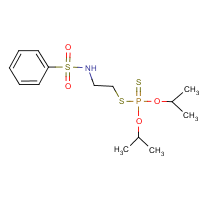Bensulide
Agent Name
Bensulide
CAS Number
741-58-2
Formula
C14-H24-N-O4-P-S3
Major Category
Pesticides

Synonyms
Benzenesulfonamide, N-(2-mercaptoethyl)-, S-ester with O,O-diisopropylphosphorodithioate; Benzulfide; Betamec; Betasan; Betasan E; Betasan G; Betasan [OBSOLETE]; Disan; Disan (pesticide); Exporsan; Kayaphenone; N-(2-(O,O-Diisopropyldithiophosphoryl)ethyl)benzenesulfonamide; N-(2-Ethylthio)benzene sulphonamide-S,O,O-diisopropylphosphorodithioate; N-(2-Mercaptoethyl)benzenesulfonamide S-(O,O-diisopropyl phosphorodithioate); N-(2-Mercaptoethylbenzene)sulfonamide S-(O,O-diisopropylphosphorodithioate); N-(beta-O,O-Diisopropyldithiophosphorylethyl)benzenesulfonamide; O,O-Bis(1-methylethyl) S-(2-((phenylsulfonyl)amino)ethyl)phosphorodithioate (9CI); O,O-Bis(1-methylethyl)-S-(2-((phenylsulfonyl)amino)ethyl) phosphorodithioate; O,O-Di-isopropyl S-2-phenylsulphonylaminoethyl phosphorodithioate; O,O-Diisopropyl 2-(benzenesulfonamido)ethyl dithiophosphate; O,O-Diisopropyl S-(2-benzenesulfonylaminoethyl) phosphorodithioate; O,O-Diisopropyl dithiophosphate S-ester with N-(2-mercaptoethyl)benzenesulphonamide; O,O-Diisopropyl phosphorodithioate S-ester with N-(2-mercaptoethyl)benzenesulfonamide; Phosphorodithioic acid, O,O-bis(1-methylethyl) S-(2-((phenylsulfonyl)amino)ethyl) ester; Phosphorodithioic acid, O,O-diisopropyl ester, S-ester with N-(2-mercaptoethyl)benzenesulfonamide; Pre-San; Prefar; Prefar E; Prefer; R 4461; R-4461; S-(O,O-Diisopropyl phosphorodithioate) ester of N-(2-mercaptoethyl)benzenesulfonamide; S-(O,O-Diisopropylphosphorodithioate) of N-(2-mercaptoethyl)benzenesulfonamide; S-2-Benzenesulfonamidoethyl O,O-di-isopropyl phosphorodithioate; S-2-Benzenesulphonamidoethyl O,O-diisopropyl phosphorodithioate; S-beta-(Benzenesulfonamido)ethyl O,O-diisopropyl dithiophosphate; SAP; SAP (herbicide); [ChemIDplus]
Category
Organophosphate Insecticides
Description
Colorless to white solid; mp = 34 deg C; [ICSC] Colorless or amber liquid above 34.4 deg C; [HSDB] Amber liquid; mp = 33-36 deg C; Supercools and may remain liquid below these temperatures; [MSDSonline]
Sources/Uses
Used as a pre-emergence herbicide for control of annual grasses and broad-leaved weeds in lawns, turf, watermelons, cotton, rice, vegetables, rice, and other crops; [HSDB]
Comments
A cholinesterase inhibitor; [ICSC] Caused mild skin and eye irritation in rabbits; Effects observed in chronic feeding studies with rats include inhibition of cholinesterase activity and minor histopathological changes of liver; [HSDB] “The average of two baseline respective cholinesterase activity determinations three days apart, with no exposures to enzyme inhibiting pesticides for at least 30 days, is recommended for each worker prior to exposure to cholinesterase inhibitors because of large inter-individual differences in published baseline values. To be established at least once a year. Removal from workplace exposures is recommended until the cholinesterase activity returns to within 20% of baseline.” [TLVs and BEIs]
Reference Link #1
Biomedical References
Exposure Assessment
BEI
Acetylcholinesterase activity in red blood cells = 70% of individual's baseline; Butylcholinesterase activity in serum or plasma = 60% of individual's baseline; Sample at end of shift; [TLVs and BEIs]
TLV (ACGIH)
0.1 mg/m3, Inhalable fraction and vapor
Vapor Pressure
8E-07 mm Hg
Lethal Concentration
LC50 (rat) > 1,750 mg/m3/4h
Explanatory Notes
Flash point = 157 deg C; [HSDB]
Adverse Effects
Hepatotoxin
Hepatoxic (a) from occupational exposure (secondary effect) or (b) in animal studies or in humans after ingestion
ACGIH Carcinogen
Not Classifiable
Other Poison
Organophosphate
Diseases, Processes, and Activities Linked to This Agent
Diseases
Occupational diseases associated with exposure to this agent:
Processes
Industrial Processes with risk of exposure: